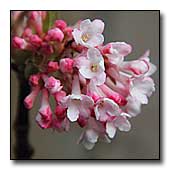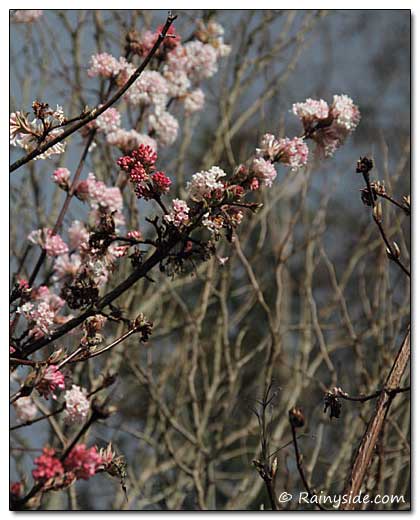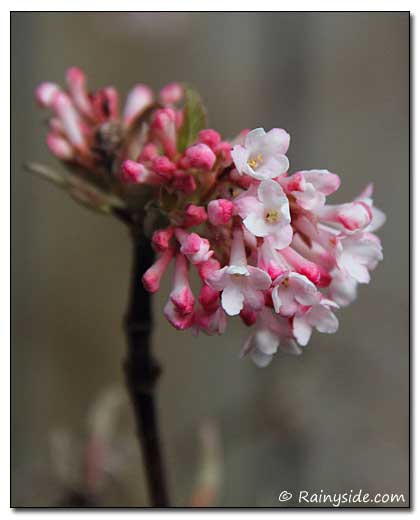Viburnum bodnantense 'Charles Lamont'
Family: CaprifoliaceaePronounced: vy-BUR-num bod-nan-TEN-see

Quick Jumps
Growing Guide
Rainy Side Notes
GROWING GUIDE

Origin:
Garden.
Plant Group:
Shrub.
Hardiness:
Sunset zones: 4-9, 14-24.
USDA zones: 7-8.
Heat zones: 8-7.
Mature size:
Height: 10 feet (3 m).
Width: 6 feet (2 m).
Flowering period:
Early to late winter.
Flowering attributes:
Pure, bright pink, fragrant flowers on dark purple shoots.
Leaf attributes:
Ovate, toothed, dark green leaves, opening in spring with bronze-tinted leaves.
Light:
Full sun to partial sun.
Soil:
Fertile, moist, well-drained soil.
Propagation Methods:
Softwood cuttings in early summer.
Hardwood cuttings in early autumn.
Pruning Methods:
Prune after flowers fade. Prune out dead or broken branches.
Pests and Diseases:
Gray mold, rust, downy mildew, verticullum wilt, and leaf spots may occur. Aphids and weevils may be problematic.
Rainy Side Notes

If you believe winter is dreadfully dull and void of flowers, think again! Meet Viburnum 'Charles Lamont', who will bloom in the dead of winter when other plants dare not flower. The extraordinary fragrance, another reason to grow it, is used to attract pollinators that are few to be found in the winter months. We enjoy the benefits of its need to propagate itself.
This winter flowering viburnum is best planted in front of evergreen shrubs so the flowers stand out against a green background. This is a wonderful addition to the winter garden along with V. 'Dawn'. Both V. 'Dawn' and 'Charles Lamont' received the RHS Award of Garden Merit. The flowers can be cut and brought in for fresh winter blooms.
By Debbie Teashon
Photographed in author's garden.

Gardening for the Homebrewer: Grow and Process Plants for Making Beer, Wine, Gruit, Cider, Perry, and More
By co-authors Debbie Teashon (Rainy Side Gardeners) and Wendy Tweton

